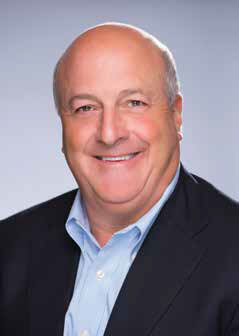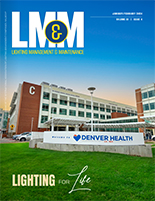 At LIGHTFAIR, EdisonReport had a conversation with John Selldorff, CEO, North and Central America, Legrand. One of the benefits of my job is having discussions with CEO’s of some of the largest conglomerates in our industry, some on-the-record and some off-the-record. Occasionally, I feel that the CEO’s are coached, leading me in a certain direction. Some have talking points that were written for them and as I pursue strategic questions, it is clear that they have limited knowledge of their business. Some executives spend too much time ‘upstream’—meaning making presentations to the corporate HQ and not enough time ‘downstream’—actually running their business. Mr. Selldorff seems to have found a happy medium.
At LIGHTFAIR, EdisonReport had a conversation with John Selldorff, CEO, North and Central America, Legrand. One of the benefits of my job is having discussions with CEO’s of some of the largest conglomerates in our industry, some on-the-record and some off-the-record. Occasionally, I feel that the CEO’s are coached, leading me in a certain direction. Some have talking points that were written for them and as I pursue strategic questions, it is clear that they have limited knowledge of their business. Some executives spend too much time ‘upstream’—meaning making presentations to the corporate HQ and not enough time ‘downstream’—actually running their business. Mr. Selldorff seems to have found a happy medium.
It is clear that he is a leader, his own man, who has the experience and the authority to make decisions. He is not a yes-man reporting to a conglomerate. Also he is a big believer in independence, allowing the businesses to do what is in their best interest. He made it crystal clear that the businesses make their own decisions. Other CEO’s have told your humble editor of similar plans, and over time, those plans change and the acquired company simply becomes a brand of the conglomerate, and gets lost. Mr. Selldorf’s passion and leadership are apparent and his body language exudes confidence.
We believe it is a great decision to leave Finelite and the other companies independent. EdisonReport will be watching and perhaps other conglomerates, as they scale down, can learn from the Legrand model and Mr. Selldorf’s leadership.
Editor: First congratulations on your acquisition of Finelite. Do you see any government issues standing in the way?
John Selldorff: We don’t see any regulatory issues so everything should close on schedule.
Editor: Legrand is relatively new to lighting, tell our audience a little about Legrand.
John Selldorff: Legrand is an approximately $6 billion dollar global company; we are number one in wiring devices, number one in switches and sockets, and number one in wire and cable management, and now we are in lighting.
Editor: How do you go to market?
John Selldorff: We sell through electrical contractors, served by wholesalers or electrical distributors. Our products tend to have unique features and benefits as we always look for ways to differentiate design. Specifically we design for ease of installation to lower the costs of those installations. Our products are more flexible so the electrical distributors have fewer SKU’s. We constantly search for ways to add value to the chain. Typically we stay away from products that cannot offer differentiation. If there is a market that is well served, there is no value for a new entrant and if we can’t add value, there is no need to enter. This is why we don’t participate in commodity products like wire and conduit.
Editor: So how does lighting fit into that philosophy?
John Selldorff: In the old market, which consisted of ballasts, lamps, and fixtures each of those three segments split the value and there would have been little opportunity for differentiation so it did not meet our standard as there was no way to provide distinguishable solutions. When Eaton bought Cooper four years ago, we said that we would never get into the luminaire business as we saw no real need to be in luminaries. However, there has been much more rapid adoption of LED, which now liberates lighting designers and product designers. LED provides more latitude for innovation.
Editor: Do you plan to be a full line luminaire company?
John Selldorff: No. We purchased Pinnacle because it made sense. At that time everyone said we were going to be in every lighting market but we are not. We don’t have to because our reps already have full lines and they can use their other lines where we have gaps. So we don’t have to provide all the pieces, only the ones that make sense and that meet our core requirements where we can add value. Acquiring OCL made sense because of their great products and our scale; we think we can triple their sales. We have been in business since 1984 and roughly one half of one percent of our sales are from the original Legrand, with approximately 99.5% of sales coming from companies we acquired.
Editor: Was Wattstopper one of your first acquisitions?
John Selldorff: Yes, we acquired Wattstopper in 1996, and in the 20 years since, we have grown the business 20X. Wattstopper is a great example of how a business can thrive, as we don’t think we know better. We offered value in that we helped scale that organization. We encouraged them and nurtured and they have had huge growth but we did not manage their business. The same is true with Finelite. Jerry Mix is very talented and will continue to run that business.
Editor: How about your future business, will you continue to acquire companies?
John Selldorff: Yes, we want to grow 50% organically and 50% by acquisition. Recently the growth has been a little more inorganic. In 1984 Legrand North America had zero sales. Today we are around $2 billion in sales.
Editor: We hear that Legrand is working on another acquisition.
John Selldorff: There are six businesses within Legrand and we will augment organic growth with the right type of companies that fit. In fact, we will pursue aggressively, but if we don’t do a deal in five years, that is OK. We didn’t pursue Finelite per se, as it was just the right time for them to look at a transaction. We are strong in wiring devices, and we want to be a major player in the spaces were are in. Legrand typically spends four to five times more than our competitors, as a percent of revenue, on R&D. We like to bring features and functions that no one thought about, especially aesthetic features. The effect of light is as important as the function of light. We are active in the market place but nothing is imminent today, however, we do get proposals all of the time.
Editor: Will there be an opportunity to reduce costs with the Finelite acquisition?
John Selldorff: We are not focused on the cost side as we try to deliver good value. We are much more focused on getting new products to market that generate good margins. We reinvest and raise the bar again.
Editor: This is refreshing to hear because so many of your competitors, large competitors, are focused on taking out cost.
John Selldorff: Don’t get me wrong, we won’t walk away from saving money, but we will let the local business decide what makes sense. But no, we won’t be consolidating factories and engineering departments. Maybe a company could earn an extra 10% or even a 20% savings with consolidation, but the risk you place on a business by a poor execution of that strategy is ten-fold the savings. The customer is really important to us and we talk about fill rate. Productivity is important, but fill rate is more important.
Another interesting point is that Philips and Osram are getting out of Lighting and we are a European company, so there are lots of questions about why we enter, as they exit. We have made the case to our investors that we have a different approach and we have a strong track record.
Editor: What about LIGHTFAIR 2018 in Chicago, will the Legrand companies be in one booth?
John Selldorff: I can’t speak for Finelite, because the deal has not closed yet, so that is up to them. As a matter of fact, I can’t speak for any of the companies, because they are independent and they will make whatever decision is best for them. Right now, I could not tell you which ones have decided to exhibit because it is up to them. While I am in charge of North America, they control their own destiny and they have their own LIGHTFAIR plans.
Editor: Will you keep the same market channels?
John Selldorff: We are organized around channels. Controls are sold through a lighting agent to the Electrical Distributor and then to the Electrical Contractor. The agent interacts with the lighting designer and customer. Some of our Controls agents are already asking about the Finelite line. No, Finelite has their own reps and they will continue to manage those reps without interference. Now, it is dangerous to say nothing will ever change, but we don’t want to disrupt existing businesses because we think we know better.
Editor: What is your thought on Lighting as a Service?
John Selldorff: We are manufacturers and we are agnostic as to how the end user pays for our product. As I mentioned earlier, we sell through traditional channels and if one of our distributor partner wishes to use LaaS, or set up a lease, or a rental, that is up to them. We want to differentiate our company by our products, not by procurement solutions.
Editor: How important is IoT?
John Selldorff: It is important, as it is a new vector of innovation but remember, we have been connecting things for decades and we have been doing wireless controls for a long time as well, so IoT is not new. One area of IoT, distinguishing between occupancy and presence, is really hard. Determining between one person, 3 people or 10 people is not easy, but it can be done. We offer a variety. If the demand is for a control in a single fixture, we can do that, but the most economical solution is to create a zone. We can do either.
But you won’t see us launching things that are not secure, not robust or not easy to implement. What if a network stops running? You need a switch to control the lights. Apps are good, but not the only way. Voice may not the best solution either because of background noise. There is a lot of value from having a physical device in addition to the network, the app, and and voice.
So the question becomes what is, and is not, good practice. We may not be on the bleeding edge, but what we do launch, you can count on.



